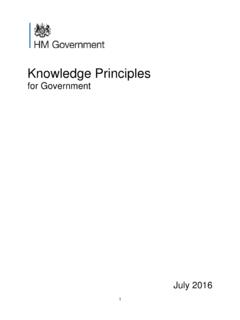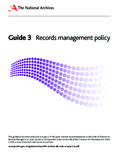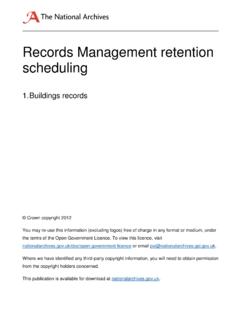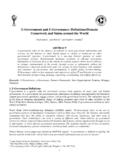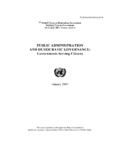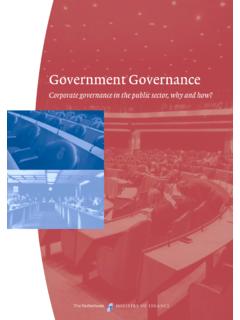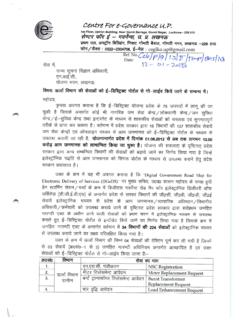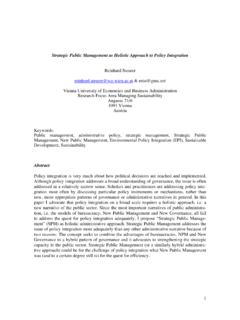Transcription of e-Government metadata standard v3 - The …
1 e-Government metadata standard / Version / 2006-08-29 - 1 - e-Government Unit e-Government metadata standard Version 29 August 2006 e-Government metadata standard / Version / 2006-08-29 - 2 - metadata Addressee metadata Working Group; Interoperability Working Group Contributor Cabinet Office, e-Government Unit, Technical Policy Team, metadata Policy Co-ordinator, Contributor metadata Working Group; metadata Technical Working Group; Integrated Public Sector Vocabulary Governance Board; Taxonomies in the Public Sector group UK Creator Cabinet Office, e-Government Unit, Technical Policy Team, metadata Policy Co-ordinator, 2006-08-29 Description The elements and refinements that provide the structure for metadata used by the UK public sector, along with introductory text Format Text Identifier Language eng Publisher e-Government Unit, Stockley House, 130 Wilton Road, London SW1V 1LQ, Crown copyright Source Status Version Subject metadata ; information management Title e-Government metadata standard Version e-GMS Type standard e-Government metadata standard / Version / 2006-08-29 - 3 - Contents 1 Introduction.
2 4 Changes since previous version .. 4 Under consideration .. 5 Other changes .. 5 What is metadata ? .. 6 Why is metadata important? .. 6 The e-GMS in practice .. 7 The e-GMS development principles .. 7 Maintenance principles .. 7 What this standard includes .. 8 8 Obligation .. 8 Purpose .. 8 Notes .. 8 Not to be confused with .. 9 Refinements .. 9 Examples .. 9 HTML syntax .. 9 Encoding schemes include .. 9 Dublin Core element .. 9 Mapping .. 9 What this standard does not include .. 10 Mandatory and recommended elements .. 10 Note on multiple values .. 10 2 Elements .. 11 Accessibility .. 11 Addressee .. 13 Aggregation .. 14 Audience .. 15 Contributor .. 17 Coverage .. 18 21 Date .. 23 Description .. 26 Digital signature .. 28 Disposal .. 29 Format .. 32 Identifier .. 33 Language .. 35 Location .. 36 Mandate .. 37 Preservation.
3 39 Publisher .. 41 Relation .. 42 Rights .. 46 Source .. 49 Status .. 50 51 Title .. 55 Type .. 57 Appendix Links and references .. 58 e-Government metadata standard / Version / 2006-08-29 - 4 - 1 Introduction The technical policies and specifications for achieving interoperability across the public sector are fundamental to the successful delivery of the Cabinet Office s Transformational government Strategy, launched in November 2005. The e-Government metadata standard (e-GMS) lays down the elements, refinements and encoding schemes to be used by government officers when creating metadata for their information resources or designing search interfaces for information systems. The e-GMS is needed to ensure maximum consistency of metadata across public sector organisations. The e-GMS forms part of the e-Government Interoperability Framework (e-GIF). Essential background and supporting documents can be found at and Changes since previous version Since the publication of e-GMS the mandated encoding scheme for the Subject element has been replaced by the Integrated Public Sector Vocabulary, prompting an update to the standard .
4 This provided the opportunity to clarify some of the editorial comments and to update examples in line with current guidance and preferred practice. Changes to elements, refinements and encoding schemes are set out in the table below. Accessibility Notes updated and encoding scheme revised Addressee government Data standards Catalogue (GDSC) data types specified Contributor GDSC data types specified Coverage Notes updated; GDSC data types specified; ISO 19115 removed as an encoding scheme Creator GDSC data types specified Date GDSC and ISO 19115 data types specified Hyphen and repetition of date removed from refinement name Digital signature Definition included Publisher GDSC data types specified Rights Legislation removed as an encoding scheme Subject Notes updated; mandatory encoding scheme replaced with the Integrated Public Sector Vocabulary (IPSV); Curriculum Online metadata scheme removed as an encoding scheme and replaced with Becta Vocabulary Bank schemes.
5 Local government Service List and Local government Interaction List added as encoding schemes Deprecated to allow the identification of the subject vocabularies by specifying the encoding scheme for the unrefined subject element Deprecated to allow the identification of the subject vocabularies by specifying the encoding scheme for the unrefined subject element e-Government metadata standard / Version / 2006-08-29 - 5 - GDSC data types specified Deprecated to reflect changes in the use of controlled lists by UK local government Name of refinement changed from Alternative Title to Alternative to comply with syntax example and Dublin Core term Under consideration Dublin Core metadata Initiative (DCMI) metadata Terms Additional conforming elements and refinements added to the Dublin Core metadata Terms: Accrual Method; Accrual Periodicity; Accrual Policy; Instructional Method; License; Provenance; Rights Holder UK GEMINI standard : A Geo-spatial metadata Interoperability Initiative Elements and refinements for describing geo-spatial, discovery level metadata within the UK ISO19115 Geographic Information/Geomatics metadata A full standard for describing geospatial and spatio-temporal metadata , at discovery level extending into descriptive level.
6 There are a number of projects involving geospatial metadata which are developing general profiles of ISO19115, including UK GEMINI standard , the European standards Working Group CEN TC/287, and a metadata Drafting Team working under the proposed EC INSPIRE Directive (INfrastructure for SPatial Information in Europe) RFC 3066 Encoding scheme for Language recommended as best practice by Dublin Core The <indecs> metadata Framework Encoding scheme for Rights vCard Encoding scheme for Creator, Contributor and Addressee Other changes The introduction has been revised at , , , , , , , , , and Further guidance has been added to the html examples to illustrate the prefix that should be used for Dublin Core (DC) and e-GMS elements, refinements and encoding scheme names. The prefix and term name for each specified e-GMS and DC encoding scheme has been included in the lists of encoding schemes for the elements.
7 Dublin Core terms have been removed from the mapping lists and displayed separately to indicate where elements and refinements are taken directly from DC. Mapping has been updated to include the UK GEMINI standard . e-Government metadata standard / Version / 2006-08-29 - 6 - Examples have been provided on how to enter multiple values. Editorial comments have been reviewed for clarity and consistency and html examples have been updated in line with preferred practice. Hyperlinks and examples have been updated in line with organisational changes Office of the e-Envoy has been changed to e-Government Unit. What is metadata ? The most common definition of metadata is data about data . A more helpful definition is that it is structured information about a resource. For example, a catalogue selling household items gives the metadata of those items: the brand, price, colour and capacity. A library catalogue contains metadata relating to books: their titles, authors, publishers, etc.
8 metadata enables a resource to be found by indicating what the resource is about and how it can be accessed with a series of structured descriptions. In its broadest sense, metadata can be used to describe information structures such as the technical standards and interconnection policies that are the province of the Interconnection, Data Integration and Access sections of the e-GIF. The e-GMS is concerned with the particular facets of metadata intended to support resource discovery and records management, and covers the core set of elements that contain data needed for the effective retrieval and management of official information. Each element contains information relating to a particular aspect of the information resource, title or creator . Further details on the terminology being used in this standard can be found in Dublin Core (see ) and the e-GIF s Technical standards Catalogue (see ).
9 Why is metadata important? The reasons for developing this standard were originally outlined in the e-Government metadata Framework (e-GMF) and are now incorporated into the e-GIF. To summarise them: Modernising Government1 calls for better use of official information, joined-up systems and policies, and services designed around the needs of citizens. Considerable work has already been done to standardise government information systems so they can be accessed easily from central portals. New systems for the handling of electronic records are being devised. Official records will not always be stored in paper format. metadata makes it easier to manage or find information, be it in the form of web pages, electronic documents, paper files or databases. For metadata to be effective, it needs to be structured and consistent across organisations. 1 Modernising government ; Cm 4310; Cabinet Office 1999; The Stationery Office e-Government metadata standard / Version / 2006-08-29 - 7 - Achieving the vision set out in the Transformational government strategy2 requires a key transformation in the approach to sharing corporate services, infrastructure, information and standards that will allow us to work together more effectively, and will release efficiencies.
10 The e-GIF is mandated across all government information systems. By association, so is the e-GMS. The e-GMS in practice The e-GMS is meant as an overall standard , a superset of all elements and refinements needed throughout the UK public sector. It is highly unlikely that one system will need all of the elements and refinements listed here. It is recommended that, in each case, a local standard is created; this will consist of a cut-down version of the e-GMS, with only the elements considered useful for local implementation. The e-GMS is flexible enough to allow the use of additional free text fields for internal use only. Some examples of these local standards can be found on the GovTalk website ( ). It may also be useful to create a user s version of your local standard , containing only the information you will need to add metadata to information resources. For this it is possible to remove details such as examples of HTML syntax and mappings, and change the examples to ones more relevant to your own organisation.
